
- This event has passed.
Full Moon Meditation – Aries / Libra
06/04/2023 @ 11:30 am - 12:00 pm
LIVING OUT THE MYTH IN THE LANDSCAPE OF ARIES ‘SPIRITUAL WARRIOR’
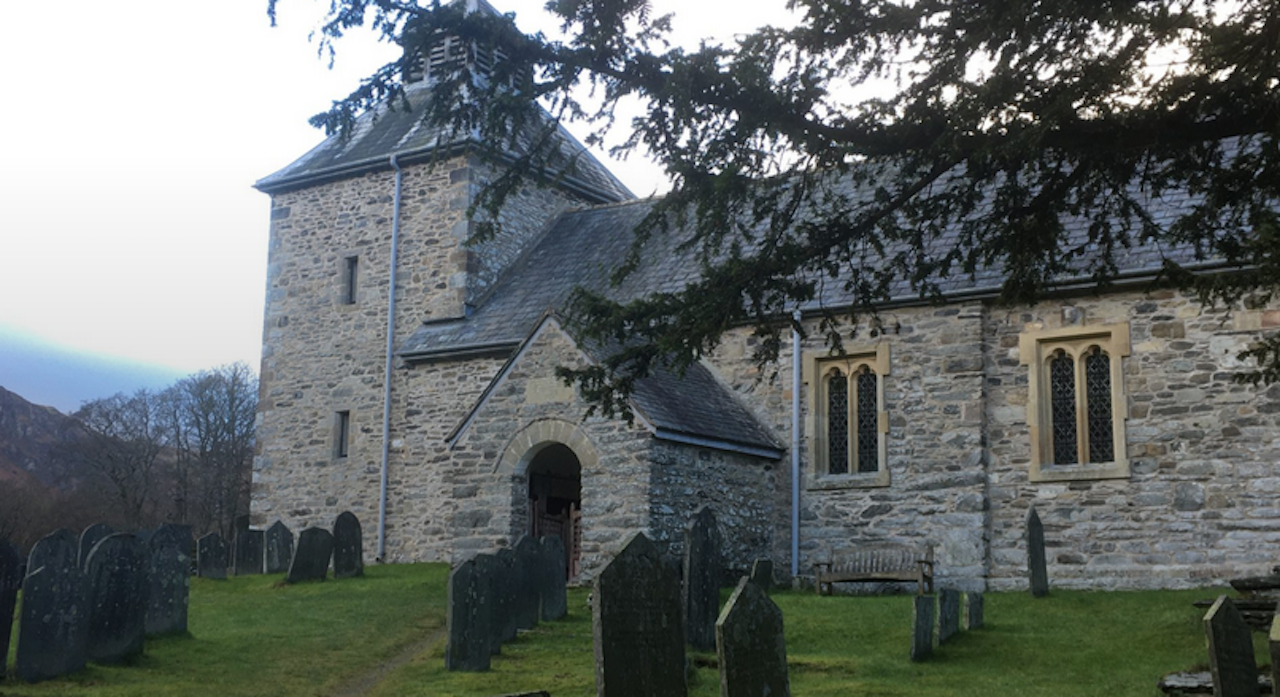
The Shrine of St Melangell is enclosed within an ancient circular graveyard bounded by old yew trees. ,,,Bronze age burial pits have been found with remains carbon dated to between 1000 and 1500 BC
https://stmelangell.org/

An ancient yew. (JK)
The Pilgrim Lane leading up to the church. (JK)
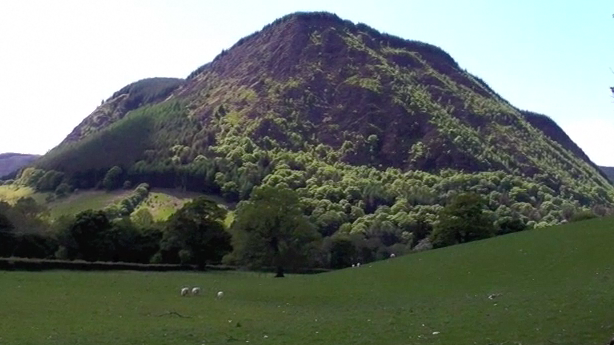
Breast shaped hill behind the church, lending its aura to the female Saint’s Shrine.
https://stmelangell.org/the-shrine-church-of-saint-melangell/
THEME FOR MEDITATION
For meditation our quest is for understanding the growth of our inner spiritual warrior, our ‘passion of purpose’ building up in our sacred space, which focuses on the spiritual ideal of nurture, protection and transformation. How do we let fly our arrow of spiritual purpose?
How can we develop as pilgrims, forming a goal, incubating it and following up with decision-making, gathering a ‘dream team’ of spiritual fellow pilgrims, a plan for nurture and protection along the way?
Local pilgrims have been visiting North Wales for many years. Many have been gathered by Jane Knight, our Gatekeeper trustee. She lived till nearly 8 in North Wales and then within the boundaries of the ancient Welsh Marches. She was always drawn to the area and very much feels part of the Celtic tribe. She wrote an article about St Melangell’s church for the Gatekeeper newsletter in September 2021, excerpts of which are below. The video which is as yet unedited from this delightful sensitive trip will be available soon for our website but in the meantime if you would like to be sent a link, please message Jane.
‘I discovered St Melangell’s Church in 2001 when I was living 5 miles west of Ludlow a few miles inside Herefordshire but with a Shropshire postal address, again an indicator of the fluid border.
Over the years there have probably been about a dozen occasions when I have woken up and known I had to be somewhere that day. I always followed my intuition when this happened. I remember going online and searching but what for? I can’t now remember. I came across the name of St Melangell and set off to Pennant Melangell at the head of the Tanat Valley in the Berwyn Hills of Powys about an hour away.
St Melangell was a female saint of the 7th century. According to tradition she came here from Ireland and lived as a hermit in the valley. One day Brochwel, Prince of Powys, was hunting and pursued a hare which took refuge under Melangell’s cloak. The Prince’s hounds fled and he was moved by her courage and sanctity. He gave her the valley as a place of sanctuary where Melangell became Abbess of a small religious community. After her death her memory continued to be honoured, and Pennant Melangell has been a place of pilgrimage for many centuries. Melangell remains the patron saint of hares.

St Melangell’s Shrine … ‘a place where God speaks in the silence and where all people have an opportunity to experience a sense of the Holy.’
Visitors from around the world are attracted to the shrine. It remains a Pilgrims' Church, attracting visitors from all over Britain and beyond. The Triple Hare, an interdenominational symbol, is found throughout SW Britain, Europe and Asia.
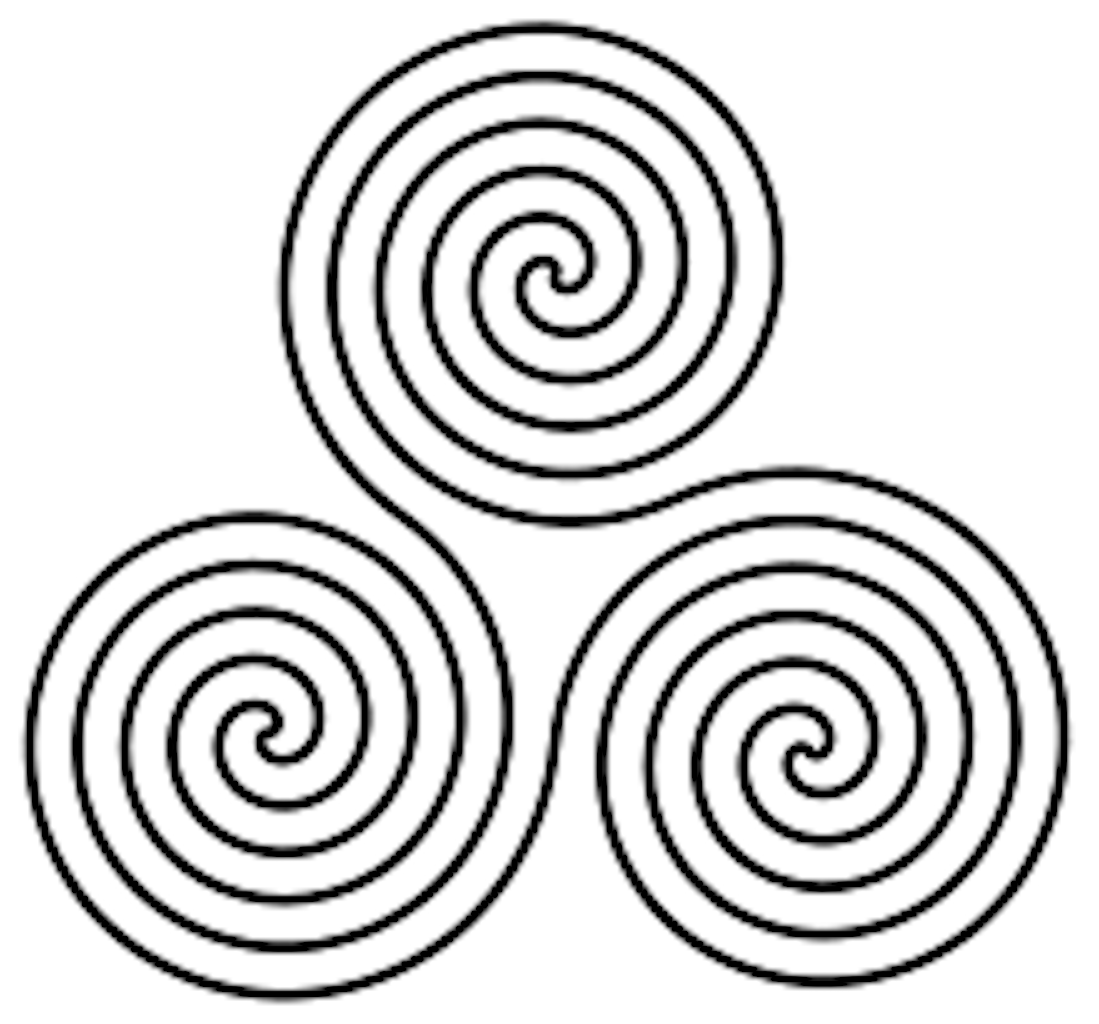
Triskele at New Grange
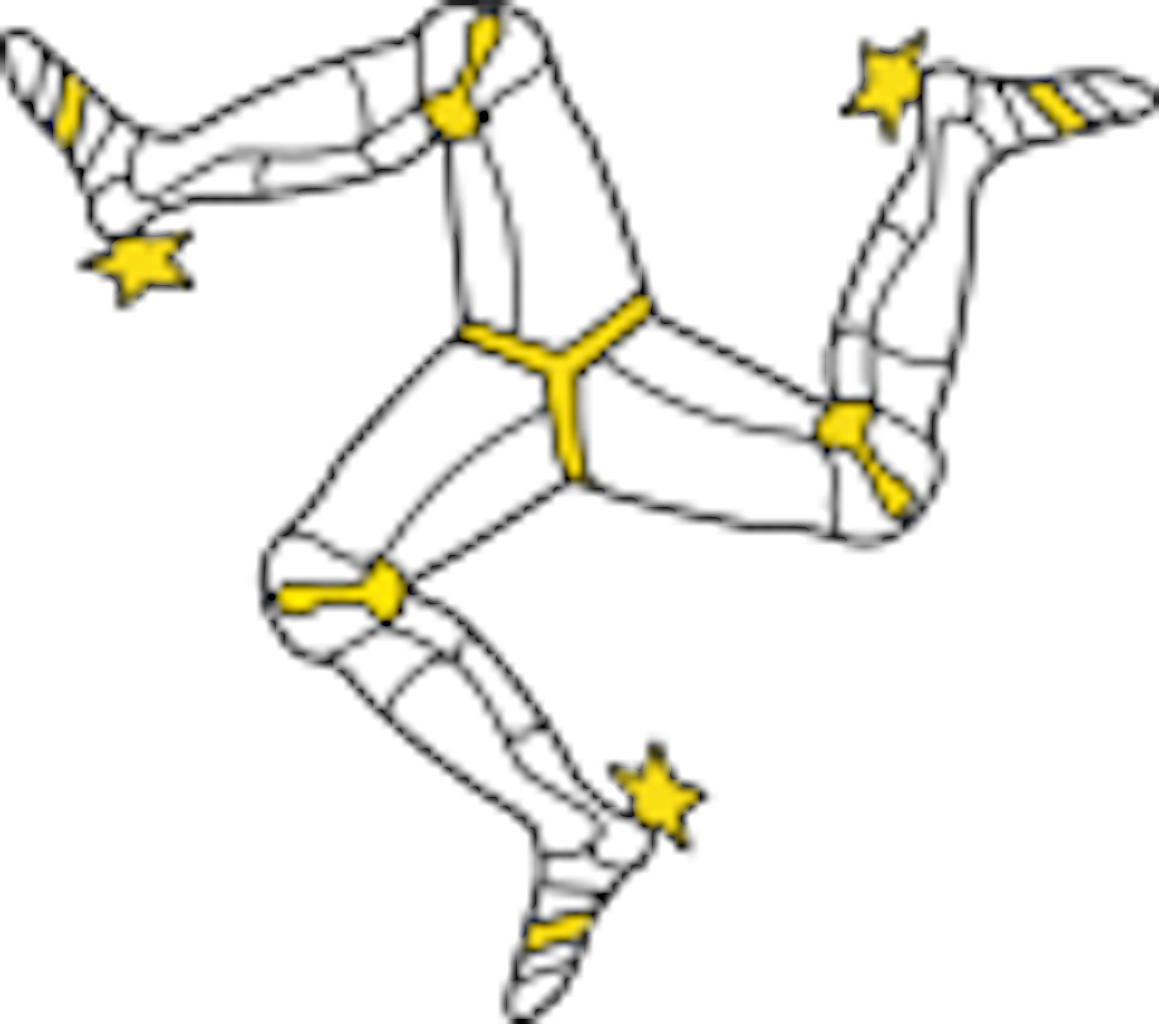
Three legs of the Isle of Man, Centre of the Hesperides/British Isles.
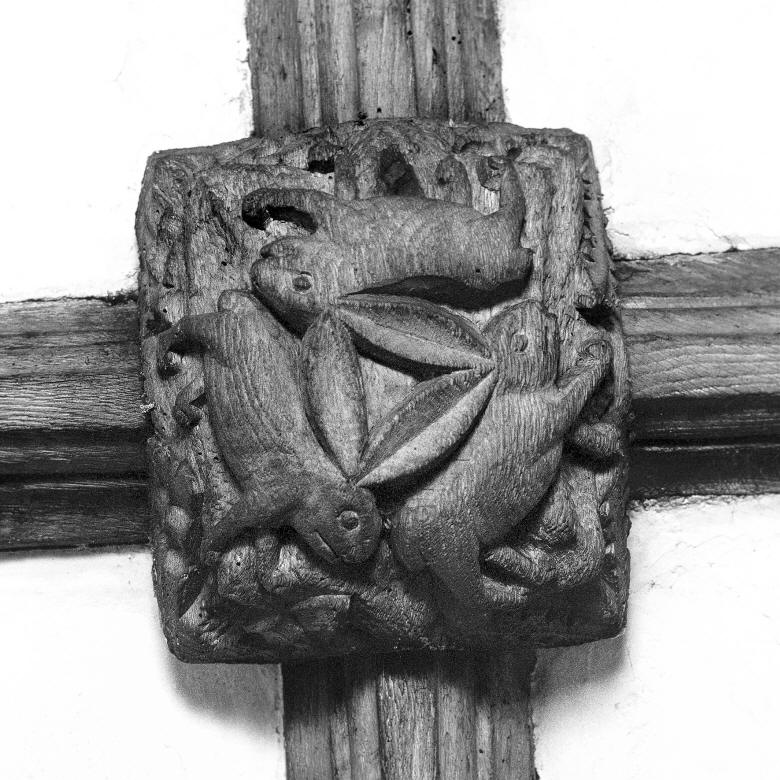
Throwleigh roof boss
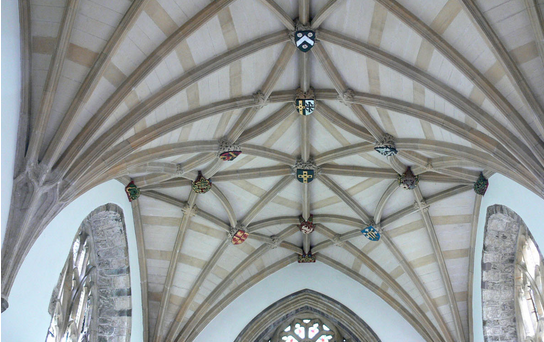
A ‘three hares’ roof boss in St Mary’s Chapel, St David’s Cathedral, Pembrokeshire.
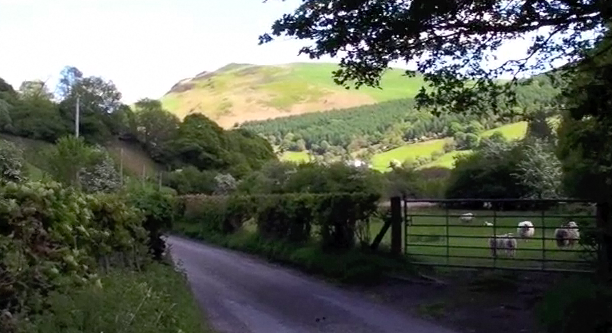
[IMAGE: Lane and hill. From a video by JK]
This is the only route in and out for cars. As I drove, I felt an increasing sense of expectation. At the end you pull into a parking area which I later discovered had been used as a gathering place in the past for outdoor meetings ... and cock fighting too apparently. The latter activity seems strangely at odds with both St Melangell’s affinity with animals and the peaceful nature of the area now, although it would have been a busier community in the past before farming practices changed.
As you enter through the lych gate and into the churchyard you feel a sense that this place has been a much-loved place of gathering for centuries and indeed millennia.
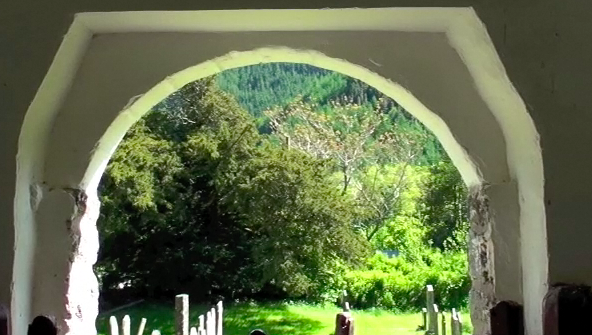
The Lychgate into the churchyard (JK), which is round and stone-walled with ancient yews which are verified to be at least 2000 years old. Inside is a plaque signed amongst others by Sir George Trevelyan and the actor Robert Hardy which certifies the yews as being at least 2000 years old.
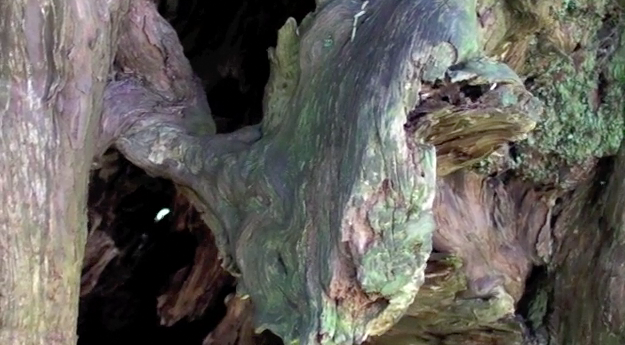
A living, ancient yew, (JK) drawing the eye into its convoluted memories of persistence, growth, ritual and devotion.
‘I find it interesting that the Reverend Christine Browne is known as the Priest Guardian of Saint Melangell’s.
Apparently, she was one of the first women to be priested in the Church of England.’ More information on the church can be found on its website. (https://stmelangell.org/the-shrine-church-of-saint-melangell/)
The full article can be found on the Gatekeeper Trust website:
https://gatekeeper.org.uk/2021/09/a-pilgrimage-to-st-melangells-church/
ARIES the SPIRITUAL WARRIOR
Within the myth of Aries is the central role of the archer aiming an arrow at a goal. In order to obtain perfect centredness, we need to focus our mind on the inner light of our sacred inner space. Only when we set aside our personal stories and preferences can we truly hold the centre to which our arrows of desire will fly. The two archetypes for this initiatory action are male and female in quality, within us all. The male is represented by the straight path of the perfectly poised arrow and steady strength of the arm. The female quality is represented by the perfect balance and holding the centre within a sacred space, the circle sanctuary of devotion and reception of spiritual purpose. The triskele in art form reminds us of the ‘holy trinity’ of perfect balance and sacred space.
In the British landscape, the ‘straight roads’ of the Celtic architects connect all directions of the zodiac. The A5 is built upon one of them and holds the myth of Brân the Blessed. Along this road his head was taken to the
‘White Hill’ in London, which is understood to be the Tower of London in which the sovereign sleeps the night before s/he is crowned.
In Wales female saints are often found within ancient circular sanctuaries, St Melangell being one of them. The archetype is of protection and incubation of spiritual power. It is about grounding landscape energy and preparing for love in action.
St Melangell is teaching the 'circular' initiatory path, building Christianity on an ancient circular Druidic/neolithic sanctuary. I like this as it is artistic for me; my visioning art is often circular. Inclusive and nurturing, it is still a virginal 'warrior' path which complements the action of service. It is about nurturing the psychic roots of vision through centring in prayer.
The story of Brân the Blessed teaches the 'straight line' of action, of shooting the 'arrow of love-light to its goal' of envisioned purpose, determined and passionate, willing to get the job done. It protects and drives a seed idea of sovereignty, creating a necessary tension like the archer’s bow with a steady arrow.
Along the A5 we find other sanctuaries which represent the dual ‘spiritual warrior’ symbology, in particular in Wenlock near to the warrior settlement on Wrekin Hill:
Princess of Wenlock: The Abbess of Wenlock Priory, St Milburga was a princess, and miracle worker. St Milburga (sometimes spelt Mildburg) lived when the peoples of Anglo-Saxon England were being converted
to Christianity. In her case, it was a community of both monks and nuns. She was well-connected not only across Anglo-Saxon England but also abroad.
As the second abbess of Wenlock, or Wimnicas as it was then known, she was one of a number of princesses who ruled over monasteries in the 7th century..
WREKIN: Wreocensetun (Mercian) or early Celtic ‘Wrikon’, is an Iron Age Hill Fort, occupied by the Uriconio, before the Romans set fire to it and moved the settlement to Wroxeter (Viroconium Cornoviorum). Built of volcanic rock, the whole area to the south also contains rich mineral rock along the ‘Stiperstones’.

[IMAGE: Stiperstones by Jane Knight]
The iron bearing rocks used for arrows, spears and swords - an Aries warrior theme.
ROUND TABLES IN THE LANDSCAPE
King Brân’s story is about sacrificing our own ideas for the sake of acting on a vision of love in action. In the story, Brân instructs his knights to cut off his head and take it to London. The story began with the royal prince of Ireland travelling, along the earliest of Celtic roads, the ancient road, the A4, brings us to London. It links yet earlier circular sanctuaries, some now incorporated into churchyards.
Interestingly, the road links with Hartshill where we as a trust began planning a new chapter - the Wheel of Life Project - and the story it tells is of the warrior’s ‘arrow’ of pure loving intent being released into the landscape through our local pilgrimage activities.
THE FIRST ROUND TABLE PALACE?
Several years ago Sarah Dawkins lead a pilgrimage along the A5 to and from Snowdonia linking the ‘White Hill’ traditions at the Tower of London. At Oldbury near Atherstone the king built what Peter considers is the first Round Table Palace with its Courtier knights. We began the Wheel of Life project at Atherstone on the edge of Hartshill, near Oldbury Camp (a large multivallate hillfort). This historical account appeared later in Adrian Gilbert’s book [‘The Holy Kingdom’] in which he reports Welsh historians found burial mounds, and a tombstone for one of the two Welsh King Arthurs (Artwys).
I went on foot where I discovered mounds on Hartshill on a solitary reccy pilgrimage in 2015, and observed the remains of the hillfort nearby which seemed impenetrable due to there being a modern reservoir and quarry built within it. It is near Ather-stone, which I envisaged related to ‘Arthur’s Stone’, the Welsh king Artwys, and another ‘round table’ site.
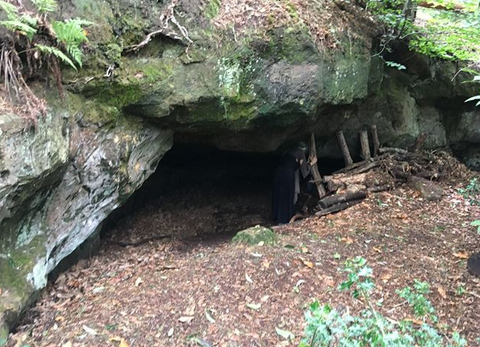
The remains of Oldbury hillfort.
https://historicengland.org.uk/listing/the-list/list-entry/1007458
Later Peter Dawkins discussed why this fort is what he considered were the remains of the palace of King Bran, and the site of the first ‘round table’ palace.
Landscape legends for today:
The and Lessons of Aries our ‘Inner Pioneer’:
It is expected that all things Aquarian include collaborative groups, unity in diversity, creativity and thoughtful vision-focused innovation. Determination and aspiration can get the job done.
It seemed to me that we have narratives holding this principle of collective wisdom that can inspire us locally. The myth of King Arthur’s Round Table might relate to the prehistoric circle sanctuaries in the land where people and priests met to divine the sacred plan and purpose of the future. For me they represent an ancient wisdom of democratic organisation for local tribes, their leaders and their priests. The priests’ divination of the astronomical patterns and their narratives, so that they linked to psychic transformation. They also created ceremonies at the alignment of the rising and setting of stars, sun and moon, so that the stories conveyed a cosmic purpose to human societies.

The Druids Circle at Penmaenmawr, North Wales
https://albion.org.uk/sites/the-druids-circle-penmaenmawr
A symbol of inclusion, and focus of the wisdom of the landscape angel, encapsulating the hills and high views of aspiration around it.
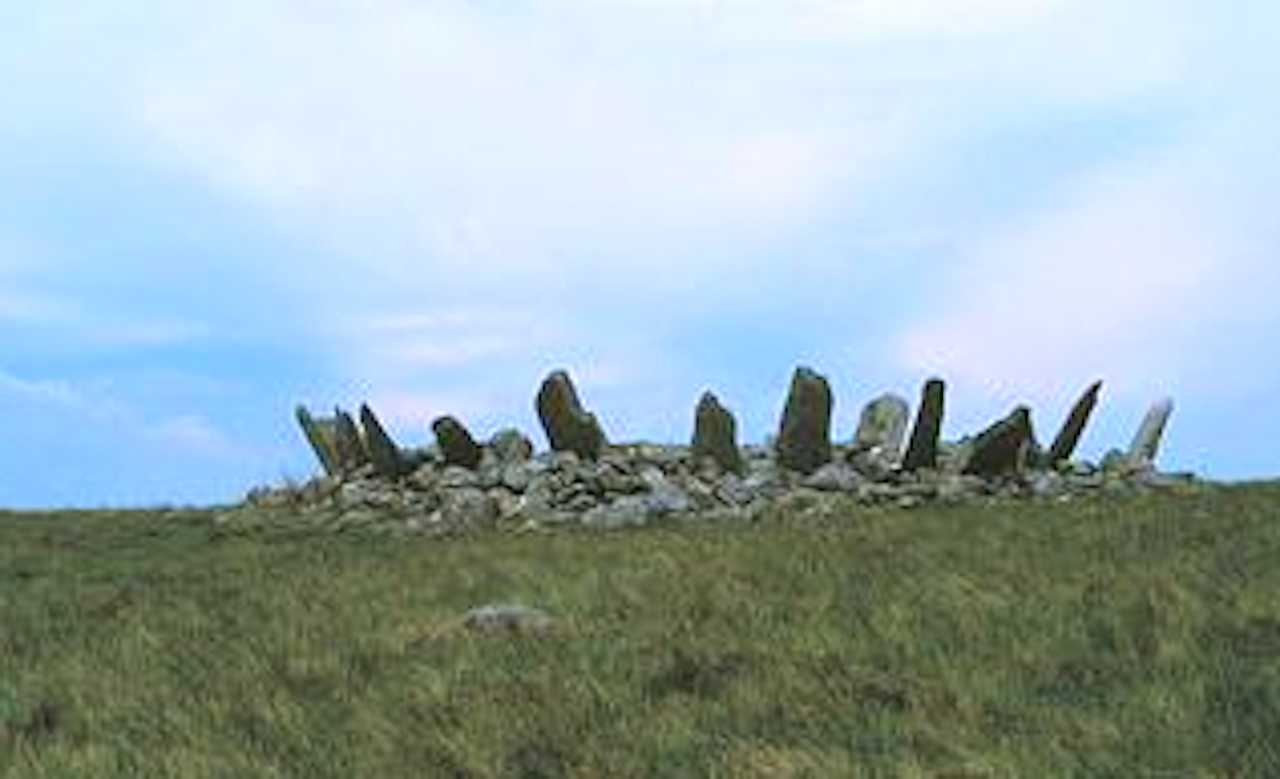
Bryn Cader Faner - Gwynedd
https://stonepages.com/wales/bryncaderfaner.html
The symbol is of a stoney crown, with a thorny path of illumination
driven by passion of purpose.
Did stone circles travel with a migrating group, from Wales to England? The holes at Waun Mawn where bluestones used to sit, suggest that the centre array in Stonehenge was built out of these Welsh rocks.
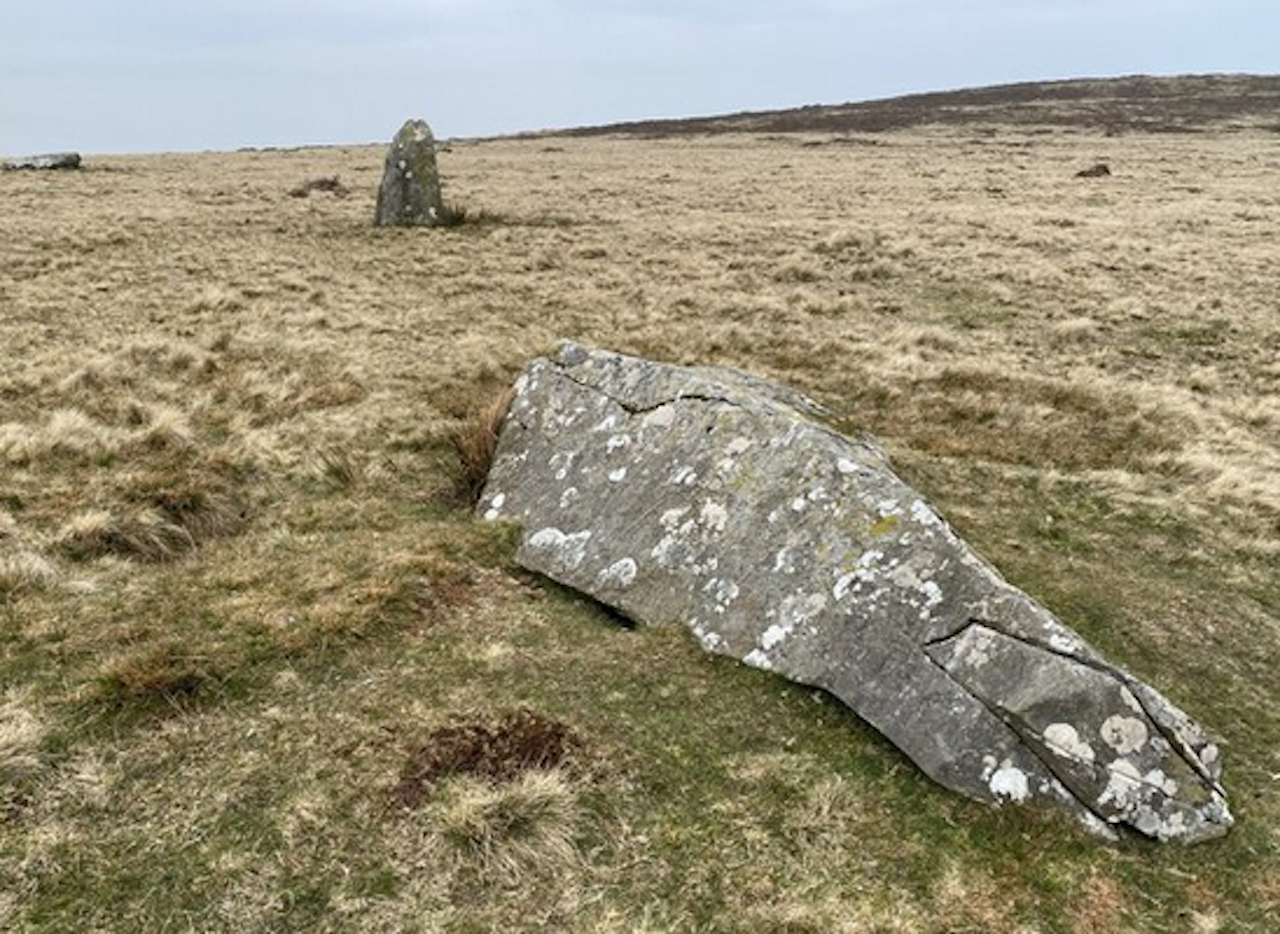
Waun Mawn (Photoby Sir Benfro) circle, the last remaining stones - aspiration of Aries drove a culture to migrate with a heavy load, the lesson is: we may become over-stretched in manifesting our desired vision, and in need of the female ‘sacred boundary’ of balance.
https://getoutside.ordnancesurvey.co.uk
The circle is situated close to a prehistoric trackway and estimates say it was built around 3000BC….There are around thirty stones, eleven still standing, set on the edge of a low embankment 35m in diameter.
https://www.itv.com/news/2021-02-12
Co-editors: Jane Knight and Charlotte Yonge, 2023.